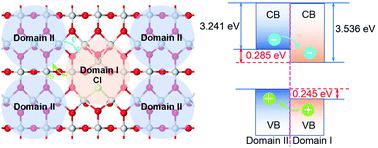当前位置:
X-MOL 学术
›
Nanoscale Horiz.
›
论文详情
Our official English website, www.x-mol.net, welcomes your
feedback! (Note: you will need to create a separate account there.)
Surface domain heterojunction on rutile TiO2 for highly efficient photocatalytic hydrogen evolution
Nanoscale Horizons ( IF 8.0 ) Pub Date : 2020-09-30 , DOI: 10.1039/d0nh00491j Kuo Lin 1, 2, 3, 4, 5 , Fang Xiao 1, 2, 3, 4, 5 , Ying Xie 1, 2, 3, 4, 5 , Kai Pan 1, 2, 3, 4, 5 , Lei Wang 1, 2, 3, 4, 5 , Wei Zhou 1, 2, 3, 4, 5 , Honggang Fu 1, 2, 3, 4, 5
Nanoscale Horizons ( IF 8.0 ) Pub Date : 2020-09-30 , DOI: 10.1039/d0nh00491j Kuo Lin 1, 2, 3, 4, 5 , Fang Xiao 1, 2, 3, 4, 5 , Ying Xie 1, 2, 3, 4, 5 , Kai Pan 1, 2, 3, 4, 5 , Lei Wang 1, 2, 3, 4, 5 , Wei Zhou 1, 2, 3, 4, 5 , Honggang Fu 1, 2, 3, 4, 5
Affiliation

|
Compared with the highly active anatase TiO2, rutile TiO2 usually presents poor photocatalytic performance due to high electron–hole recombination. Herein, we propose a surface domain heterojunction (SDH) structure between adjacent micro-domains with and without chemisorbed chlorine on rutile TiO2, which utilizes the potential difference between these domains to form a built-in field that promotes charge separation. Single-crystal rutile TiO2 nanorods assembled into radial microspheres with SDHs were fabricated, and these exhibited excellent solar-driven photocatalytic hydrogen evolution, ∼8-fold higher than that of the pristine one. Experimental results and density functional theory calculations reveal that the exceptional photocatalytic performance can be attributed to the in situ formation of chemisorbed chlorine, which forms SDHs that separate electrons and holes efficiently and results in surface reconfiguration, exposing the tri-active sites, increasing the O-site active centers and enhancing the catalytic activity of the 4-coordinated (Ti4c) and 5-coordinated Ti sites (Ti5c). This SDH strategy can extend to other halogen elements and thus provides an universal approach for the rational design of high-efficiency TiO2 photocatalysts toward sustainable solar-fuel evolution.
中文翻译:

金红石型TiO2上的表面域异质结,用于高效光催化制氢
与高活性锐钛矿型TiO 2相比,金红石型TiO 2通常由于高的电子-空穴复合而表现出较差的光催化性能。本文中,我们提出了在金红石TiO 2上有和没有化学吸附氯的相邻微畴之间的表面畴异质结(SDH)结构,该结构利用这些畴之间的电势差来形成促进电荷分离的内置场。单晶金红石型TiO 2制备了用SDHs组装成放射状微球的纳米棒,这些纳米棒表现出出色的太阳能驱动的光催化氢放出,比原始的高约8倍。实验结果和密度泛函理论计算表明,优异的光催化性能可归因于化学吸附氯的原位形成,该形成的SDH可有效分离电子和空穴,并导致表面重构,从而暴露出三活性位点,增加了O位活性中心并增强4位(Ti 4c)和5位Ti(Ti 5c)的催化活性)。这种SDH策略可以扩展到其他卤素元素,从而为合理设计高效TiO 2光催化剂以实现可持续的太阳能发展提供了一种通用方法。
更新日期:2020-11-03
中文翻译:

金红石型TiO2上的表面域异质结,用于高效光催化制氢
与高活性锐钛矿型TiO 2相比,金红石型TiO 2通常由于高的电子-空穴复合而表现出较差的光催化性能。本文中,我们提出了在金红石TiO 2上有和没有化学吸附氯的相邻微畴之间的表面畴异质结(SDH)结构,该结构利用这些畴之间的电势差来形成促进电荷分离的内置场。单晶金红石型TiO 2制备了用SDHs组装成放射状微球的纳米棒,这些纳米棒表现出出色的太阳能驱动的光催化氢放出,比原始的高约8倍。实验结果和密度泛函理论计算表明,优异的光催化性能可归因于化学吸附氯的原位形成,该形成的SDH可有效分离电子和空穴,并导致表面重构,从而暴露出三活性位点,增加了O位活性中心并增强4位(Ti 4c)和5位Ti(Ti 5c)的催化活性)。这种SDH策略可以扩展到其他卤素元素,从而为合理设计高效TiO 2光催化剂以实现可持续的太阳能发展提供了一种通用方法。











































 京公网安备 11010802027423号
京公网安备 11010802027423号